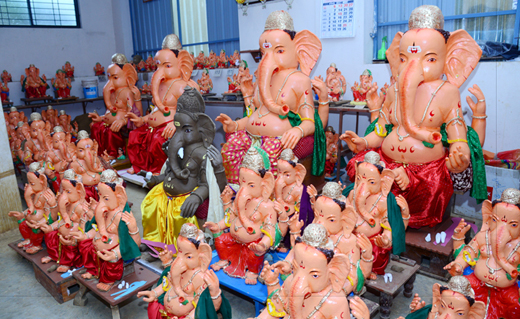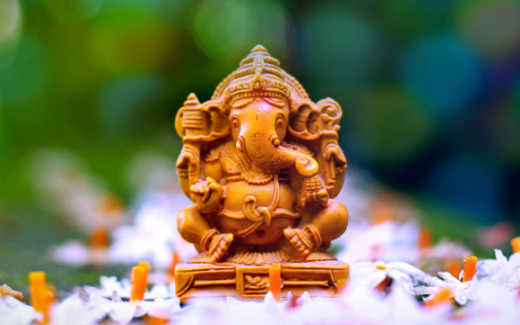Ganesh Chaturthi: The significance and the celebrations of the 10-day long festival
Ganesh Chaturthi: The significance and the celebrations of the 10-day long festival
Mangalore Today News Network
Mangaluru, August 24, 2017: Lord Vinayaka, Ganesh ji, Ganpati ji, Vinayaka is the darling of the masses. Ganesh Chaturthi brings people of all castes and creeds together.
The Ganesh Chaturthi 2017 Puja Muhurut to bring the Vigraha / Idol home is during the Shubh, Labh or Amrit Choghadiya. If you intend to bring Ganpati ji one day before, i.e. on the 24th August 2017, the Shubh time is between 06:25 to 07:59 (AM) and the Labh time is 12:41 to 14:14. Ganpati ji can also be brought home (Avahana or Welcome) during the Amrit time which is between 14:14 to 15:48. The Muhurut for evening time would be the Amrit time which is between 18:56 to 20:22. Please note these Timings are as per panchang of Mumbai, India.

The Ganesh Staphna (installation of the Idol) on Ganesh Chaturthi day, i.e. on 25th August 2017 can be done at Labh time between 07:59 to 09:33 or Amrit Time i.e. between 09:33 to 11:07. Ganesh Pooja is preferred during Madhyanhana on Ganesh Chaturthi as it is believed that Lord Ganesh was born during Madhyahana Kaal which is between 12:40 and 14:14. The Muhurut time specified above is the best Muhurut to perform the Ganesh Puja and to perform any work.
Ganesh Chaturthi is celebrated with great devotion all over India. People bring home murtis (Idols) of Lord Ganesha and celebrate the festival by worshiping the Lord in a special way for a day and a half, 3 days, 5 days, 7 days or 10 days depending on the family tradition and commitment of each individual.
On the last day of worship the idol is taken out in a colourful and musical procession to be immersed traditionally at a beach.
This is one of the most popular festivals in the Country. There are several reasons for this. Ganpati is after all a popular God. His blessings are invoked at most religious ceremonies as He is the one who can remove all obstacles to success. He is the giver of fortune and can help to avoid natural calamities.
Ganpati, the god of wisdom and the benevolent deity of the dynasty of Peshwas who ruled Maharashtra inculcating a special culture in the state. Ganpati is the herald of auspicious beginnings and is the beloved deity of all.
Legend:
Traditional stories tell that Ganesha was created by the goddess Parvati, consort of Shiva. Parvati created Ganesha out of sandalwood paste that she used for her bath and breathed life into the figure. She then set him to stand guard at her door while she bathed. Shiva returned and, as Ganesha didn’t know him, he didn’t allow him to enter. Shiva became enraged and asked his follower gods to teach the child some manners. Ganesha was very powerful, being born of Parvati, the embodiment of shakti (or power). He defeated the godly-followers (called "Gana"s) and declared nobody was allowed to enter while his mother was bathing. The sage of heavens, Narada, along with the Saptarshi (the seven wise rishis) sensed a growing turmoil and went to appease the boy with no results. Angered, the king of Gods, Indra attacked the boy with his entire heavenly army but even they didn’t stand a chance. By then, this issue had become a matter of pride for Parvathi and Shiva.

After the devas were defeated, the trinity, the controller, preserver and destroyer of the universe launched an attack against Ganesha. Amidst the fighting, Shiva severed the head of the child and brought on Parvathi’s rage. Seeing her son dead, Parvathi revealed her true self, as the Adi-shakti, the prime energy that fuels the universe and sustains matter. Taking on a terrible form, she vowed to destroy the universe where her son was killed and re-create a better one. The gods prostrated before her and Shiva promised that her son will live again. The trinity hunted the world for a head and came across a mother elephant crying for her dead baby. They consoled the mother and fixed the head of the baby elephant in place of Ganesha’s head. Lord Shiva also declared that from this day, the boy would be called as "Ganesha" (Gana-Isha: lord of the Ganas). In this way, Ganesha came to be depicted as the elephant-headed god.
It is believed that Ganesh bestows his presence on earth for all his devotees during this day. It is the day Shiva declared his son Ganesha as superior to all the gods, barring Vishnu, Lakshmi, Shiva and Parvati. Ganesh is widely worshipped as the god of wisdom, prosperity and good fortune and traditionally invoked at the beginning of any new venture or at the start of travel.
The historical significance
Ganesha Chaturthi celebrations were started in Maharashtra by Maratha ruler Chhatrapati Shivaji in order to promote culture and nationalism. Freedom fighter Lokmanya Tilak was also the one who encouraged a grand public celebration of the festival as he saw it as an opportunity to bring people together after the British banned public gatherings during India’s Independence struggle. After he saw that all sections of the society celebrate the festival with equal fervour, he used the grand mass celebrations to in order to unite the Brahmins and the non-Brahmins.
’Mangalore Today’ Wishes you all a Happy and a Blessed Ganesh Chaturthi 2017!
- Substance abuse - A pressing concern among medical students
- China is winning the trade war without fighting
- Poll promises can become political nightmares
- While India sticks to death by hanging other execution methods vary across the world
- Spiking of drinks, a grave threat for students’ security
- Burden of drugs and substance use among university students in India
- Mangalore medic’s miracle in Bombay 1957
- Needed a national protocol for treatment of substance use disorders
- The Lingering Menace of Drug Abuse Among the Indian Youth—It’s Time for Action
- Need For ‘Students, Alcohol and Drugs’ survey
- New Synthetic Drugs Trapping Youth
- Mood Modifying Chips - Future of Drug Use
- Ramping up Indo-Bangla border security
- Kashmir Bhavan in Bengaluru: A must visit place
- "MAI and I" Book of Angelic Emotions
- Draupadi Murmu - The New ’President of India’
- Anthony Ashram in the city grows a classic museum
- First College of Fisheries in India - A Golden Jubilarian
- Flushing Meadows - A Vintage Mansion
- The Colonel�s Bequest
- A Mangalorean PM and his RBI Governor Brother: The Extraordinary story of the Benegal Brothers
- There is no higher religion than Truth: Theosophical Society
- L�affaire - Ashu & Yiju of Mangalore
- Mangalore in Kowloon
- 1568 to 2018 AD: 450 years of Christianity in Mangaluru
- Vice President elect Naidu moves on from nadir to zenith, the phenomenal journey
- Embracing the Outdoors: How Heated Jackets Are Revolutionizing Cold Weather Activities
- Efficient and Sustainable Packaging Solutions with FIBCs
- The Hybrid Kilt Revolution | Where Tradition Gets Trendy
- Affordable Elegance | Embrace Style on a Budget with Cheap Kilts
- Unleashing Style and Functionality | Exploring Tactical Kilts
- Mangalore’s Heroic Lady marks 105th Birthday
- Santa the Christmas spirit
- Geriatric care: Mangalore strikes a fine balance
- The Don Who Made Two Empires to Clash
- CHITRAPUR SARASWATS - A Great Kanara Community
- Our new President Ram Nath Kovind’s significant journey to Rashtrapathi Bhavan
- Marriages made in heaven, big fat weddings made in India
- Eid insight - The giver of glad tidings
- CITY INFORMATION
- TRAVEL
- TOURIST INFORMATION
- HEALTH CARE
- MISCELLANEOUS




 Write Comment
Write Comment E-Mail To a Friend
E-Mail To a Friend Facebook
Facebook Twitter
Twitter  Print
Print 

